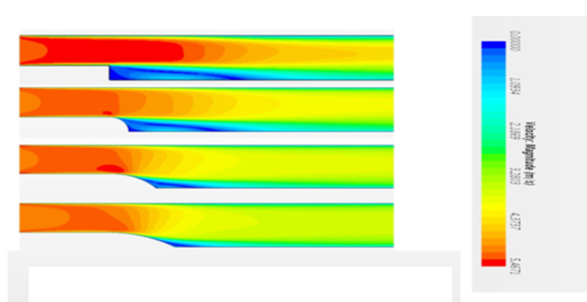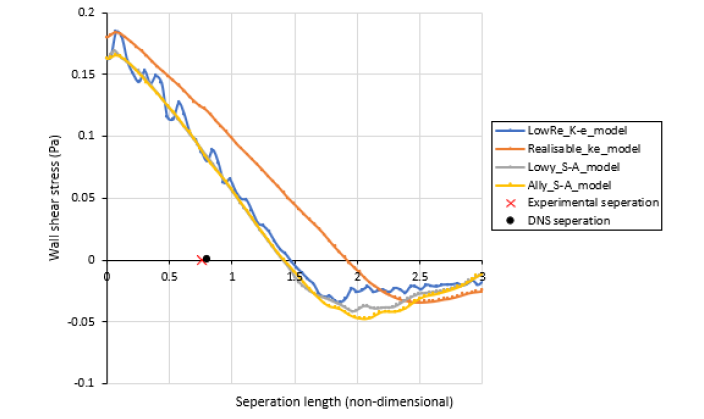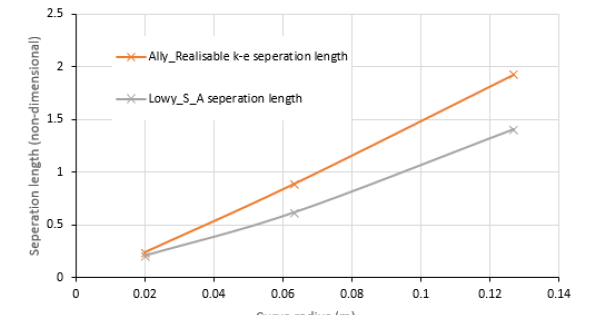- Submissions

Full Text
Evolutions in Mechanical Engineering
Separation Capture from Curved Surfaces Using Various Turbulence Models
Jason Knight1*, Mathew Whittington1, James Buick1, Burhan Saeed2 and Reza Ali3
1School of Mechanical and Design Engineering, University of Portsmouth, UK
2Department of Aeronautics, Imperial College London, UK
3School of Mechanical, Aerospace and Automotive Engineering, Coventry University, UK
*Corresponding author:Jason Knight, School of Mechanical and Design Engineering, University of Portsmouth, UK
Submission: March 27, 2023;Published: July 31, 2023

ISSN 2640-9690 Volume4 Issue5
Abstract
The accurate modelling of flow separation from a curved surface using Computational Fluid Dynamics (CFD) is computationally expensive. In the work presented here, we use a curved backward facing step and report separation length predictions using varying curvatures and four different turbulence models. The Spalart-Allmaras model results showed the closest agreement with experiment on the separation length, which is shown to vary proportionally with the amount of curvature of the step.g
Introduction
Flow separation is a phenomenon in fluid mechanics which usually occurs when a fluid experiences an adverse pressure gradient. This pressure gradient may arise from several factors, such as an obstacle in a stream or a curved surface. The flow separation from a sharp well-defined corner can be modelled accurately using limited resources in CFD [1]. Whereas the separation from a contoured or curved surface is much more difficult to capture accurately. Inaccurate predictions can lead to incorrect pressure distributions and hence inaccurate predictions of lift and drag. Multiple turbulence models have been developed in literature, each with their own benefits and drawbacks. In this work we use the Low Re k-e model, the Realizable k-e model and the Spalart-Allmaras model with low and all y+ wall functions. We use Star CCM+ software to create the domains and model the air flow over a standard and curved backward facing steps all with a height of 0.02m. The inlet has a height of 0.04m and the outlet is 0.06m. The step starts at 0.1m and the total length of domain is 0.4m. A Reynolds number of 13700 based on the inlet height is used throughout which corresponds to an inlet velocity of 5m/s at standard atmospheric conditions. The results presented here are all in 2D and have been run with varying mesh densities to confirm mesh independent solutions to within 1%. An analysis was also carried out in 3D and found to be within 2%.
Result
The velocity magnitude contour plots for the standard straight and three different curved steps are shown in Figure 1 using the Realizable k-e model. The general flow field results are very similar to the other turbulence models. The amount of flow recirculation is clearly shown in Figure 1. The extent of the slower recirculating ‘blue’ region is shown to reduce with higher curvatures. This is due to adverse pressure gradients in the boundary layer being more severe with lower curvatures (steeper gradients) so flow struggles to stay attached, thus separating earlier. The recirculation length is the reattachment minus separation length and normalized for the step height. As the curve becomes ‘steeper’ reattachment length becomes longer. For the shallow 0.127m radius, the non-dimensional recirculation length is 2.69, whereas for the steeper 0.02m radius, the recirculation length is 6.09. The larger the curvature of the step, the later the fluid separates from the step and the earlier the fluid can reattach to the wall.
Figure 1:Velocity magnitude contour plots at Re 13700 to compare flow fields of backward facing steps of a) 0.02m height and curved steps of b) 0.02m, c) 0.06 and d) 0.12m radius.

The separation point is identified where the wall shear stress is zero and the fluid has separated from the surface. As can be seen in Figure 2, the separation lengths are all longer than that found in experiment [2] and DNS [3]. Both y+ Spalart-Allmaras models yielded the closest match to experiment, closely followed by the Low Re k-e model whereas the Realisable k-e model gave the worst prediction for separation. The results from comparing different curved geometries and two different CFD models can be seen in Figure 3 which shows separation length changing with curve radius. This gives a good comparison not just on the curved geometry effect, but also between two different turbulence models. Better predictions have been obtained in similar work [4], by increasing cell density in the vertical direction. However, such measures violate wall function conditions so that drag is inaccurate. In Figure 3, the separation length increases approximately proportionally with the radius, for the range of values considered here. The difference between the Spalart-Allmaras and the Realisable model for separation length can also be seen to increase as the radius is increased. The Spalart-Allmaras model gives a better prediction to that obtained by experiment, but improvements are needed to accurately capture both separation and drag at reasonable computational expense.
Figure 2:Separation length comparison using different CFD models for curved step of 0.127m.

Figure 3:Separation length comparison using different curvatures and turbulence models.

References
- Al-Jelawy H, Kaczmarczyk S, Alkhafaji D, Mirhadizadeh S, Lewis R et al. (2017) A computational investigation of a turbulent flow over a backward facing step with open FOAM. Proceedings-2016-9th International Conference on Developments in eSystems Engineering, Liverpool, UK, pp. 301-307.
- Song S, Eaton JK (2004) Reynolds number effects on a turbulent boundary layer with separation, reattachment and recovery. Exp Fluids 36: 246-258.
- Barri M, Khoury G, Andersson H, Pettersen B (2009) DNS of backward-facing step flow with fully turbulent inflow. International Journal for Numerical Methods in Fluids 64(7): 778-792.
- Knight J, Lucey A, Shaw C (2001) On the aerodynamic loading and deformation of convertible car roofs. SAE Technical Paper, p. 10.
 a Creative Commons Attribution 4.0 International License. Based on a work at www.crimsonpublishers.com.
Best viewed in
a Creative Commons Attribution 4.0 International License. Based on a work at www.crimsonpublishers.com.
Best viewed in 







.jpg)






























 Editorial Board Registrations
Editorial Board Registrations Submit your Article
Submit your Article Refer a Friend
Refer a Friend Advertise With Us
Advertise With Us
.jpg)






.jpg)













.bmp)
.jpg)
.png)
.jpg)














.png)

.png)



.png)






